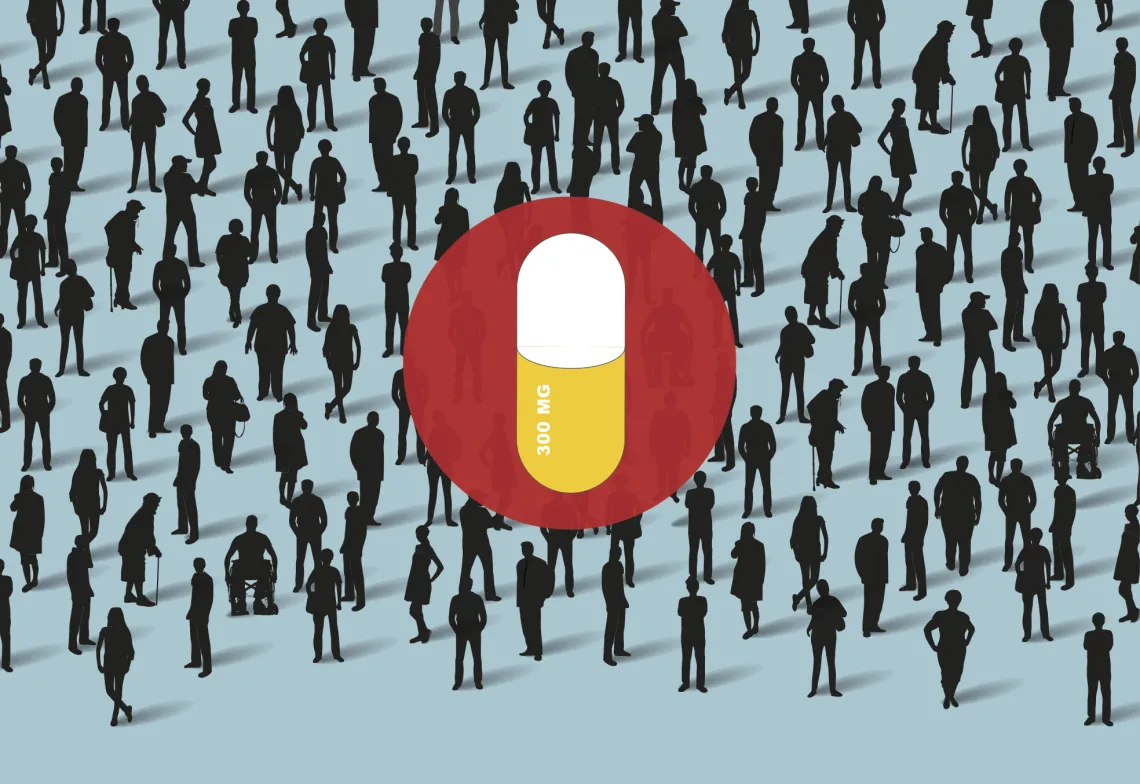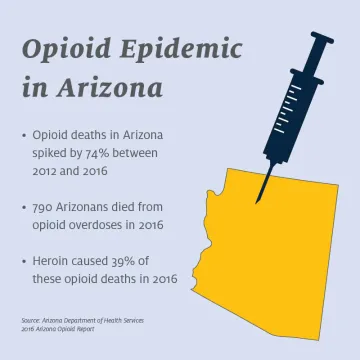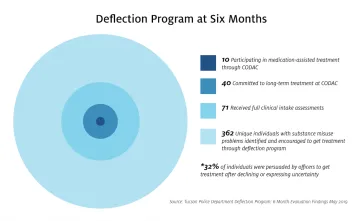In the Local Fight Against Opioid Addiction, You Matter
An unprecedented team effort is addressing the local opioid epidemic with a new approach that’s as effective as it is compassionate: Fewer arrests; more treatment.

(Graphic by Colleen Loomis/RII)
On a 109-degree day in Tucson, police officers Erik Morales and Christopher Ciarvella were walking through De Anza Park handing out bottles of Gatorade, bags of chips and beef jerky, and naloxone kits—emergency treatment for opioid overdoses.
Morales and Ciarvella weren’t there to arrest anybody—in fact, Morales hadn’t made an arrest in over a year.
“The role of being a cop is evolving,” Morales says. “We’re public servants first, and to deal with an issue like a national epidemic, we need to get out in the community, reach out a helping hand and make positive changes.”
Two years before he and Ciarvella showed up in De Anza Park, the Arizona Department of Health Services released a report that found 790 Arizonans died from opioid overdoses in 2016, and opioid deaths in Arizona had spiked by 74% in just four years. It was enough for Governor Doug Ducey to declare a public health emergency.

(Graphic by Emily Litvack/RII)
By then, Tucson Police Department (TPD) Assistant Chief Kevin Hall was already acutely aware of the toll opioids were taking on residents of Tucson, and he knew two things: Arresting people with substance use issues, on average, wasn’t decreasing their substance use issues and, consequently, the department needed a new approach.
Hall heard about deflection programs—programs designed to identify individuals with substance use issues and get them connected to appropriate treatment and services. He liked the idea, and partnered with a local treatment provider, CODAC Health, Recovery & Wellness, to implement TPD’s first deflection program in July 2018.
He partnered with researchers from the University of Arizona's Southwest Institute for Research on Women, or SIROW—housed in the College of Social and Behavioral Sciences—to evaluate whether the program is working.
Pima County's Criminal Justice Reform Unit, or CJRU, led a planning effort with TPD and SIROW to submit a grant proposal to the Substance Abuse and Mental Health Services Administration, or SAMHSA. The team successfully received a three-year, $1.47 million grant from to support SIROW's evaluation and continue expanding the project, called Unified Medication Assisted Treatment Targeted Engagement Response, or U-MATTER. The SAMHSA funds are now managed by the CJRU, a department created by Pima County Administrator Chuck Huckelberry and headed by Assistant County Administrator for Justice and Law Enforcement Wendy Petersen.
“U-MATTER was created as a collaborative project involving government, law enforcement, treatment providers and us researchers to address the local opioid epidemic—a very significant public health and social issue we have in Pima County—and try to improve community well-being,” explains SIROW director and U-MATTER’s lead researcher Josephine Korchmaros.
A New Approach Emerges
Before the deflection program, people who were caught using substances or carrying drug paraphernalia were arrested. The new approach is very different.
“Police probably have the most contact with people who use illicit substances in our community,” Morales says. “And having all of this contact means we have the opportunity to prevent the loss of life.”
The TPD deflection program has three components. Officers are now trained to steer those they encounter using illicit substances away from arrest, instead offering to connect them to treatment and services. Additionally, any community member can approach an officer or any TPD facility to ask for help getting connected to treatment, and the officer must help immediately.
The program also includes active outreach efforts. TPD officers and peer support outreach specialists from CODAC (whose salaries are paid by the SAMHSA grant), go out into the community and encourage those with substance use issues to get treatment.
In its divergence from the old ways of policing a community (citations and handcuffs), this last one is profound.
Riding Along with TPD and CODAC
As Morales and Ciarvella pull up to De Anza Park with CODAC peer support co-responders Brendan Bond and Bryanda Acuña, a few people notice the uniforms and scatter. Morales says, in years past, interactions between the police and those in the substance use community have not always been positive.
When he was growing up, Morales’s mother and father used and sold drugs. Police would show up at their Tucson home to break up drug-fueled domestic disputes.
“I had an issue with the police,” Morales says. “Because, unfortunately, they would always walk away.”
One morning, Morales woke up to find his parents deceased. His father had killed his mother and himself in an apparent murder-suicide.
“I really feel like that was the beginning of my life,” says Morales, who spent his formative years in the care of Child Protective Services before he was adopted at the age of 11.
Later, as an adult, he would enter law enforcement to right the wrongs of his childhood. Morales, now a cop for 14 years, says he’s doing that through U-MATTER.
“Every human being has a right to live a fruitful life and to be loved, and nobody should have to do it alone,” he says.
Back at the park, Morales, Ciarvella, Bond and Acuña approach those who stay, offering snacks, the naloxone kits, a quick briefing on how to administer the naloxone and plain old conversation.
“At first, when we walk up, it’s awkward,” Bond says. “They’re like ‘What the heck are the cops doing here?’ But we tell them ‘Don’t worry. You’re not in trouble. We’re just out here seeing if anyone is in need of treatment.’ And I tell them about the different resources CODAC provides.”
They offer rides to CODAC for those interested in treatment. On this particular day, in four hours, they bring three people in for treatment and schedule pick-ups for at least two more.
Bond is familiar with CODAC’s treatment options not only as a peer support specialist, but as a someone in recovery himself. At 17, Bond started taking Percocet and oxycontin before becoming addicted to heroin. Bond was forced to detox during several jail stays but always relapsed upon his release. After years in this vicious cycle, Bond’s probation officer offered him the chance to go to CODAC. He’s now four years sober.
Bond explains that no matter how a person with substance use issues winds up in the deflection program, all roads lead to various treatment and services, including a full clinical intake to have physical, mental, and behavioral health needs assessed; overnights at detox facilities; housing and vocational assistance; out-patient group therapy; and medication-assisted treatment, or MAT.
“Opioids make significant changes to the brain,” Korchmaros says. “MAT allows them to not have to deal with the challenges of withdrawal symptoms so that they can focus on other components of their treatment, like cognitive behavioral therapy to address the issues underlying their substance use.”
MAT manages the physical symptoms of withdrawal, but it’s not a replacement for opioids. It only helps people move far enough along in their treatment to get in a stable place and address their triggers before tapering off a prescribed medication like suboxone, methadone or Subutex.
Bond underwent MAT to get sober: “I got on Suboxone, worked the program, and talked about my life and my history in therapy. CODAC and MAT services finally helped me move forward.”
The Data Are In
With six months of data gathered and analyzed, Korchmaros reports in the Tucson Police Department Deflection Program: 6 Month Evaluation Findings May 2019 report that 362 unique individuals were identified through the program as having substance misuse issues and were connected either immediately to services or were given resources and encouraged to do so. Of those 362 people, 71 received full clinical intake assessments (the first and most important step towards getting necessary treatment), 40 committed to long-term treatment at CODAC, and 10 are participating in MAT through CODAC.
When people who were offered treatment by field officers said they were unsure or did not want to go, the officers were able to encourage these people to accept it 32% of the time—thanks to crisis response and motivational interviewing trainings paid for by the SAMHSA grant.

(Graphic by Eddie Canto/RII)
Individuals who receive MAT can volunteer to share information about their recidivism, mental health, living situation, and vocational situation for the SIROW researchers to include in their evaluation, which is conducted by Korchmaros, SIROW research coordinator Tamara Sargus, and research technician Fedora Preston-Haynes.
“Even through U-MATTER, these individuals are not required to participate in the evaluation. They have a choice to do that, but we have found that most individuals like that component because they get to share their experience,” Korchmaros says.
Korchmaros prepared the six-month progress report, detailing some of the outcomes of the deflection program and U-MATTER. In it are anonymous biographies and quotes from individuals who received treatment through U-MATTER.
Ann was deflected when she was 30 weeks pregnant and has been engaged in MAT for her opioid use disorder for all six months since then. Consequently, she has reunited with her parents and son.
“I was able to get off the streets and go home to my parents,” she says. “I have been coming to CODAC every day.”
Laura was deflected and has been engaged in MAT for her opioid use disorder for the last month.
“I am going on three weeks clean from heroin. I don’t think I could have done this without this program,” she says.
SIROW, TPD, and CODAC recently received an additional $550,000, three-year grant from Arnold Ventures to support the work. Through the grant, SIROW will be able to do an even more comprehensive and rigorous evaluation of TPD's Deflection Program in the coming years, including an analysis of the costs, outputs, and outcomes of the program.
“The U-MATTER project is different than anything else because you’re giving people a chance. I got arrested for having drugs and paraphernalia, and I went to jail,” Bond says. “But now we’re giving people a chance to get help and get clean before they get arrested. I look at this program and wish it was around when I was using.”
As SIROW continues to run the numbers on the deflection program, the team is developing a handful of new partnerships, including with Arizona Superior Court Pretrial Services so that individuals with substance misuse issues in the court system could be identified and connected to services. With efforts led by Pima County, the project team is also forming partnerships with the Tucson Fire Department and some local hospital emergency rooms to identify people who are suspected of overdosing on opioids so they may connect sooner to treatment and services.
“I’ve always been focused on social justice issues and creating a world where everybody has a chance to reach their potential,” Korchmaros says. “And I think that’s what U-MATTER is doing for people with substance misuse issues, by offering opportunities and decreasing barriers.”

